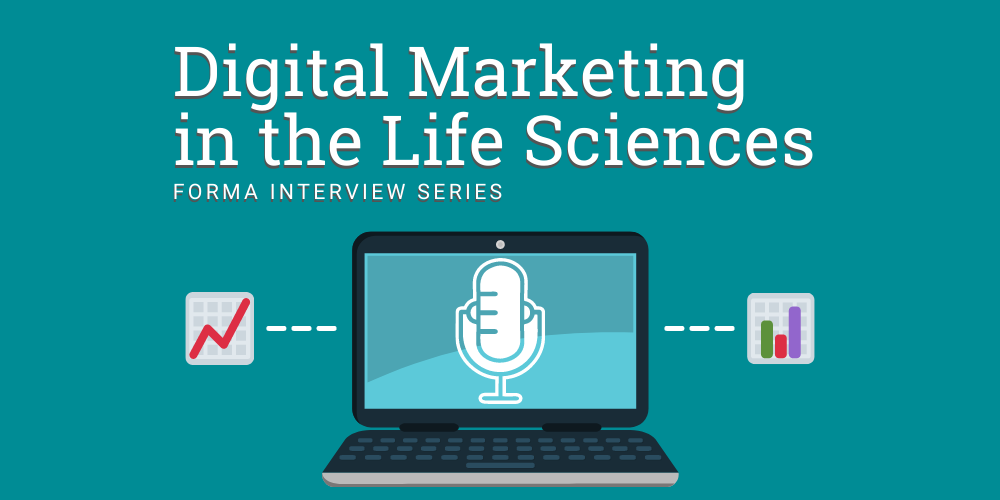Forma Interview Series: Digital Marketing in the Life Sciences
By Jordan Eller

Digital marketing in the life sciences is often misunderstood and underutilized.
Where do you devote your resources to maximize conversions? Should you incorporate a paid ad strategy, or double down on your organic performance (or both)? Does your website need a few optimizations, or a brand new look?
These are questions we see often in our work with life science companies. That’s why we’ve begun asking the Forma team to expand on their thoughts and provide guidance for those who are curious about subjects like sales strategies, design impact, and in this case, digital marketing in the life sciences.
We’ve asked Forma Digital Marketing Manager Jordan Eller to provide a quick rundown of some digital marketing answers.
If you’re trying to decide whether to partner with an agency to support your sales and marketing efforts, check out our handy guide: Internal Teams or External Marketing Agencies? 8 Crucial Factors to Consider
Question 1: How do you define “digital marketing”?
“In its simplest form, digital marketing is all about using the power of the internet to market your brand. This can take many forms, from website optimizations to search engine marketing (SEM) to developing new content strategies. There’s a lot to unpack, but a good starting point is an audit of your website. I’ll talk more about that in a bit.”
Question 2: Where do life science companies succeed with digital marketing? Where do they fail?
“Each life science company has different strengths and weaknesses. Sometimes a company will approach Forma for help with a revamped website. Other times, we’ll be asked to develop a content strategy to improve brand trust and engagement. In general, life science companies are usually successful at identifying their audience. Whether it’s a lab instrumentation company or a clinical research organization, they typically have a good idea of who their buyers are.
One of the more common issues we see in the life sciences is a lack of content. It’s important to continually deliver content to your audience. The benefits are twofold:
- Search engines love content. If Google’s search engine algorithm notices that you’re consistently updating your website with new, unique, and relevant content, it will reward your URLs with higher rankings.
- Humans love content. If a potential buyer sees that you’re publishing blogs, whitepapers, and press releases, they’re more likely to trust you and engage with your brand.
Every life science organization is unique, and it’s important to take a hard look at your digital marketing strategy in order to stay current and grow.”
Question 3: In your opinion, what are the 3 most important elements of a successful digital marketing strategy?
“Here’s a quick checklist:
- A modern, responsive website. Your website is the singular most important part of your digital marketing strategy. As the world continues to shift more and more towards digital experiences, it’s crucial that your website provides a positive experience for your audience.
- A consistent content strategy. You don’t need to write a ten-thousand word dissertation in order to see traffic growth. In many cases, posting one 500-word blog per month can drive traffic and result in higher rankings on the SERPs. Consistency is key!
- Direct, honest communication with your audience. This can take many forms, like social media or email marketing. Make sure you’re taking every opportunity to connect with your audience and establish trust in your brand.”
Question 4: Is there a common misconception about digital marketing?
One of the common misconceptions is that digital marketing is that you will begin to see results immediately. Implementing a successful digital marketing strategy is a long process. Sometimes it can take months for your digital marketing efforts to bear fruit.
Patience is key when it comes to monitoring your digital marketing performance. If you’re expecting a 50% traffic increase after publishing a single blog, you may need to readjust your expectations. But don’t let this prevent you from taking digital marketing seriously: it’s the single best way to expand your brand’s footprint and boost sales in the market.”
If you’re looking for a partner to help get your digital marketing strategy off the ground, reach out to Forma today.
Question 5: When organizing a digital marketing strategy, where’s the best place to start?
“Start with your website. Pretend you’re a regular user and navigate throughout the site on both mobile and desktop versions. Are your pages slow? Is your imagery outdated? How many clicks does it take for someone to contact you?
There is a slew of great (and free!) tools you can use to analyze your website. One of my favorites is Screaming Frog, which is a handy tool for crawling your site and identifying performance problems. Once you have an idea of the state of your site, you can then start rolling out digital marketing initiatives like an improved content strategy or pay-per-click advertising.”
Digital marketing in the life sciences can take many forms. If you’re ready to take your marketing strategy to the next level, contact us today to learn how Forma can help elevate you above your competitors.





